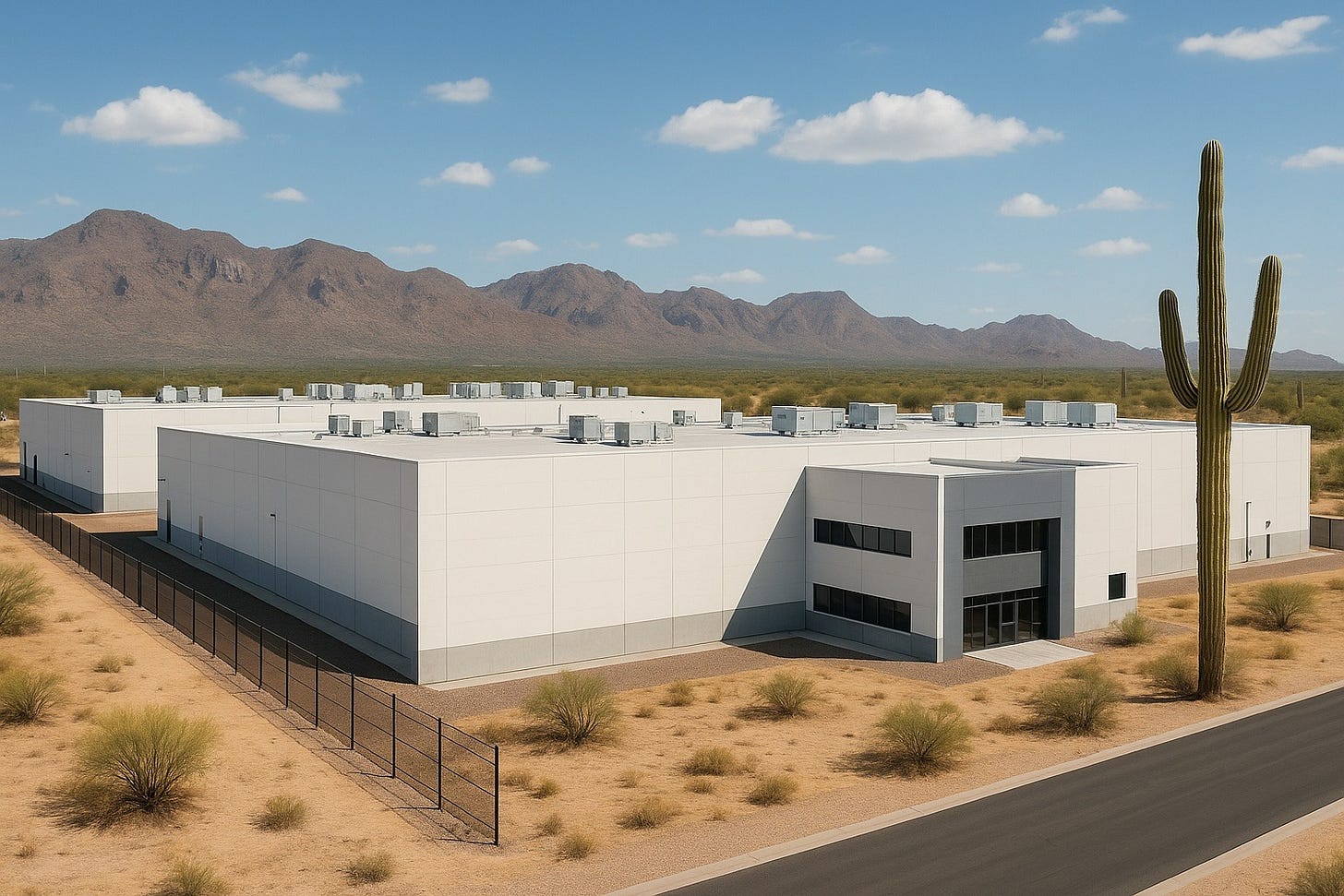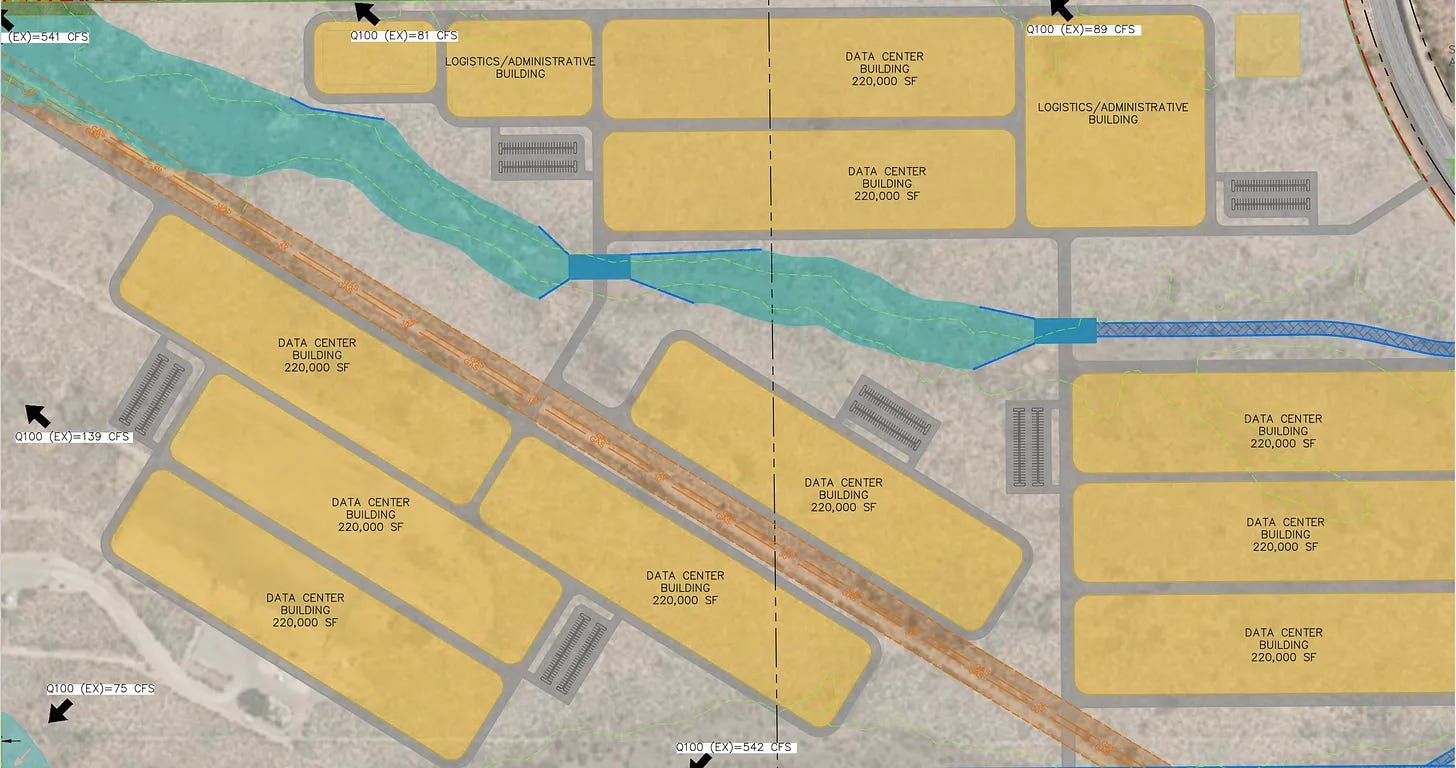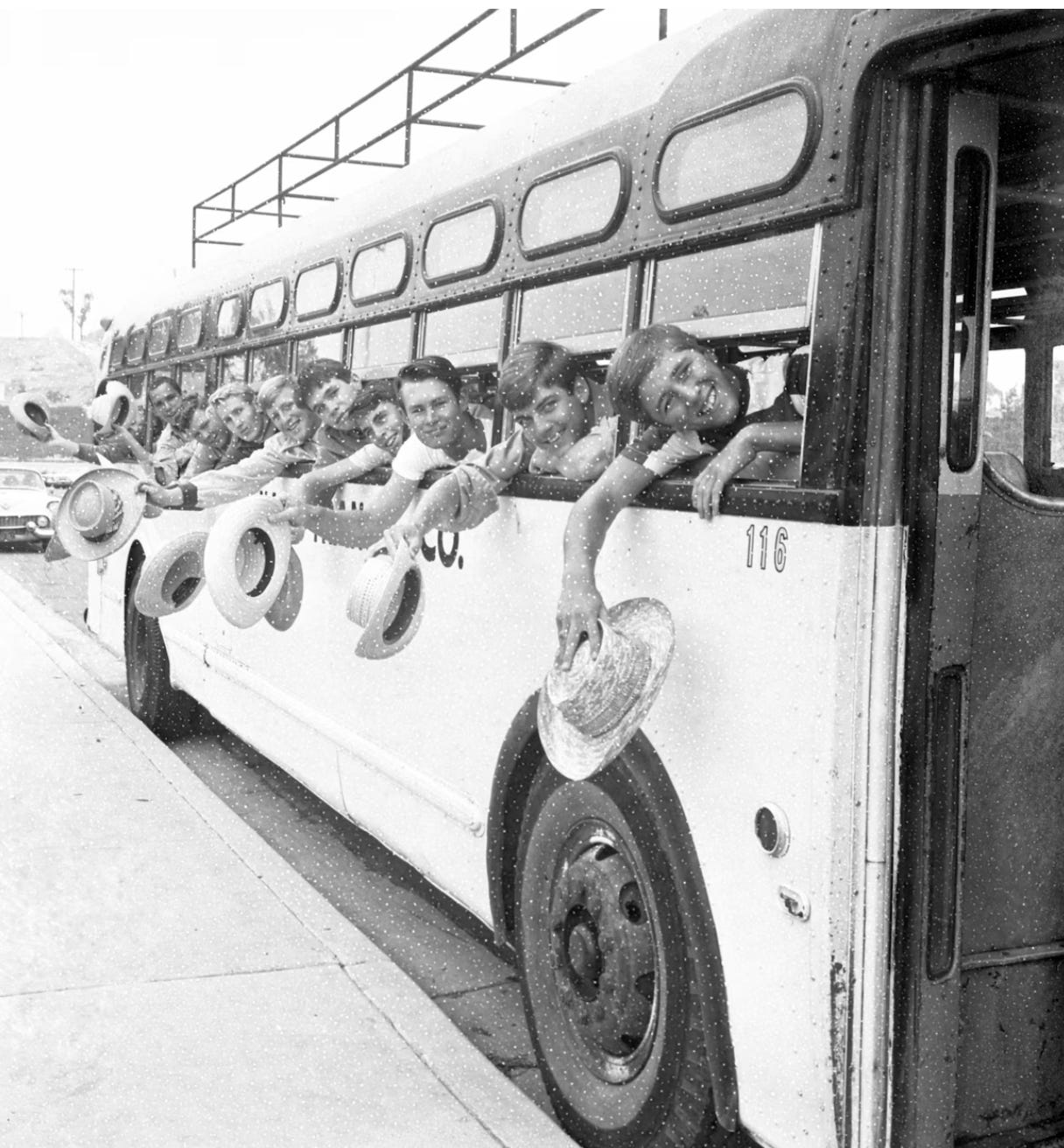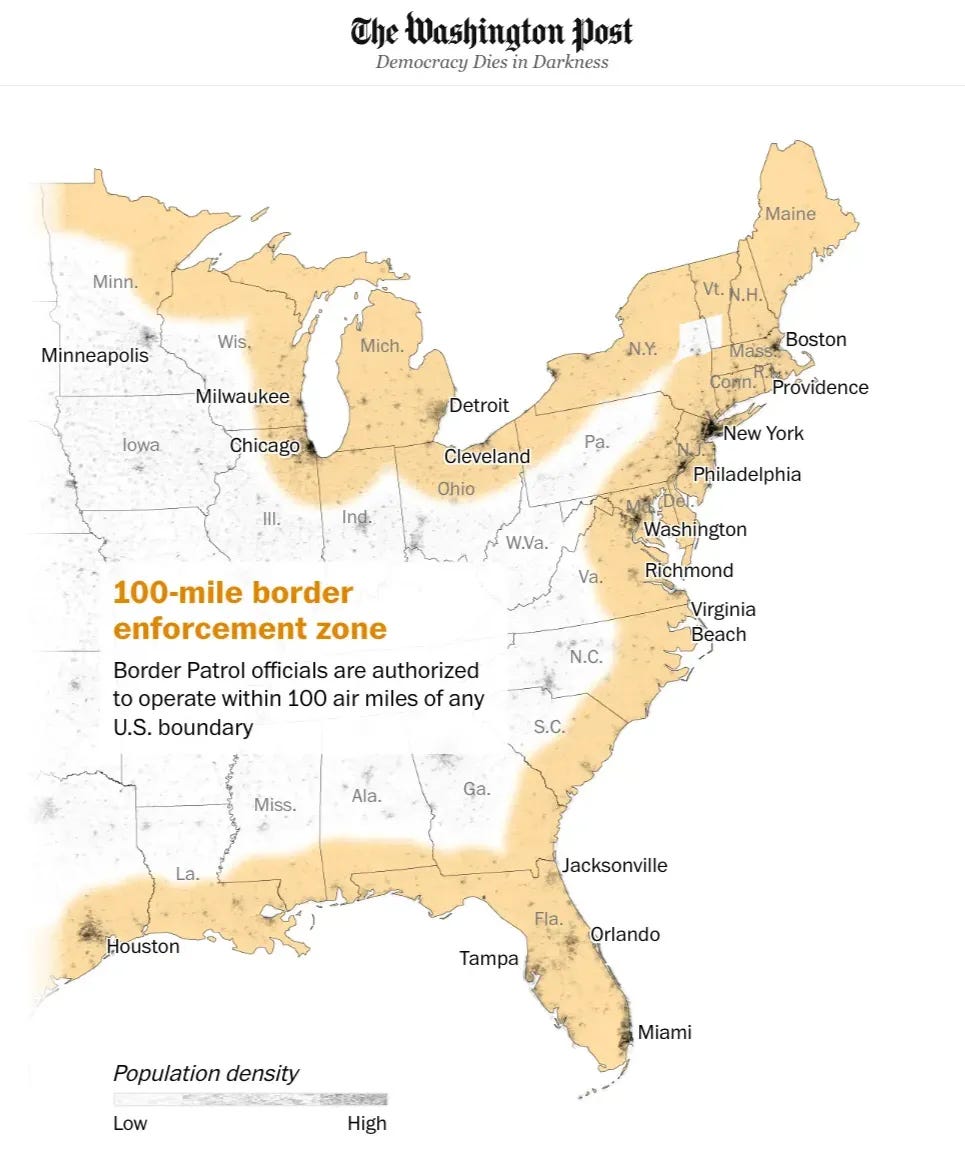What we know so far
Live or in-person? ... Project Blue poll ... It didn't work well last time.
Tonight, the City of Tucson will hold its first public meeting on Project Blue.
Or, as we now know it, a massive cluster of water-thirsty, energy-hungry data centers planned for Tucson on behalf of one of the world’s largest companies, Amazon Web Services.
Ahead of the two-hour meeting on the southside, here’s a quick primer on what we know — and what we don’t — as of Tuesday, July 22. (For context, discussions with local officials, especially city staff and county bureaucrats, date back to at least 2023.)1

Our art intern, ChatGPT, is getting scary good at drawing data centers — though it forgot to include parking lots for employees... or did it?Quick Reference: What’s being built?
Before diving into the numbers, it’s worth defining a few key terms. The developer and public officials use similar labels to describe different stages of the project, which can be confusing.
Initial phase: Construction of infrastructure to deliver water and energy to a 290-acre site Pima County sold to a proxy for the developer. The initial phase includes up to four massive data centers, with the goal of having them operational by 2027.
Full build-out: The eventual development of up to 10 data centers on the same 290-acre site. No timeline has been announced.
Second phase: A larger, still-undisclosed site elsewhere in the greater Tucson area. This site would require even more water and energy than the first, though the number of data centers and construction timeline are still unknown.
Jobs
The number of jobs that Project Blue would create depends on who you ask. We’re focusing on two categories: temporary construction jobs and permanent roles tied directly to the data centers.
Roughly 5,000 jobs will be needed to build the data centers and supporting infrastructure. Many will require skilled, likely unionized labor. Some local officials are concerned there’s no guarantee the developer won’t bring in out-of-state workers for part of the job.
75 permanent, full-time jobs with an average salary of $75,000. While the developer has claimed it will create 180 jobs, only the 75 jobs number appears in the sales-purchase agreement, a legally binding agreement between Pima County and Project Blue.

This helpful rendering of the 290-acre site from Pima County includes the plans for full build-out of the data center campus.Water
The city has outlined how the developer plans to make the project “water-positive,” but local reaction has been skeptical. The developer has pledged over $100 million to build an 18-mile reclaimed water pipeline, reducing its dependence on Tucson’s potable water.
The initial phase is expected to use 43 million gallons per year. The developer has about two years to use potable water while the reclaimed line is under construction.
The second phase would use an estimated 663 million gallons annually — all reclaimed water.
City officials say Tucson has enough reclaimed water to meet those demands. Used water from the data centers would flow into the sewer system, be treated, and then reused.
The broader Project Blue proposal includes a mix of investments in city infrastructure including: fixing leaky water pipes, converting sites like the city landfill to reclaimed water use, and buying water credits.
That combination could make the project “water-positive,” but again, skepticism remains.
Importantly, the usage estimates are just that — estimates. If the developers exceed them, they’ll pay a higher rate. What’s unclear is whether the city has the authority to cut off water service if usage continues to exceed projections.
These agreements are not final. The Tucson City Council must vote to annex the land into city limits — a requirement for Amazon to receive water service.
Energy
We recently sat down with Ed Hendel, co-founder of Sky Island AI, to talk about Project Blue’s energy demands.
Hendel is both an AI expert and a member of the city’s water advisory committee — an unusual combination. He understands the technological need for data centers but believes Tucson is the wrong place for them.

We placed the dial at the midpoint for Project Blue’s two campuses, taking a middle-of-the-road approach for how much energy the two campuses will use.Using what he considers a “fairly conservative” estimate, Hendel says the developer will use an estimated 4.8 terawatt-hours (TWh) annually. By comparison, Tucson residential customers used 4 TWh in 2023, according to this self-reported data set.
He notes that review of the Meta-run data centers show year-over-year increases in energy.
“None of them plateaued,” he said.
Tucson Electric Power boasts it has the ability to deliver 9.2 TWh annually, and has identified a short-term power supply to meet the initial demand for Project Blue.
TEP has said it is dedicated to finding a mix of renewable energy sources and battery solutions to expand its ability to produce energy locally for the long term. But the company hasn't gotten into the specifics of how it will generate the additional energy without stressing the existing grid.
Today's public meeting on Project Blue will be held at Mica Mountain High School, 10800 E. Valencia Road. It's scheduled to start at 5 p.m., and doors open at 4:30 p.m.
Can’t make it to the meeting? Stream it here.
Covering one of the largest economic development proposals for Southern Arizona takes a lot of reporting. Help support independent, local journalism by becoming a paid subscriber today.
Now that we know Amazon Web Services is the company behind Project Blue, what do you think?
Is that better or worse than you imagined?
Are you relieved it’s Amazon? Do you dread having Jeff Bezos become a big player in Tucson’s economy?
Chime in with a comment!
Sanctuary in the crosshairs: After an off-duty Customs and Border Protection officer was shot in New York, Department of Homeland Security Secretary Kristi Noem blamed sanctuary city policies, per The Hill. The shooting also spurred Trump’s border czar Tom Homan to say he plans to “flood the zone” in sanctuary cities with ICE agents, the Guardian reported. Tucson isn’t technically a sanctuary city, but it remains to be seen how valid that distinction is in the eyes of Trump officials.
Foreign-born Republicans: Tucson-area Republican Sen. Vince Leach got in some hot water after he posted a meme on social media that showed Minnesota Democratic Rep. Ilhan Omar and asked who she and 31 other foreign-born members of Congress “really represent,” the Arizona Mirror’s Jerod MacDonald-Evoy reports. That includes U.S. Rep. Juan Ciscomani, who was born in Mexico. And four of the six Arizona state lawmakers who are foreign-born also happen to be Republicans like Leach.
Champagne problems: Gubernatorial hopeful Karin Taylor Robson raised less than her Republican rival Andy Biggs, Capitol Media Services’ Howard Fischer reported. But Robson loaned her campaign more than $2 million, which gave her the fundraising edge over Biggs. So far, Robson has spent much of that money on advertisements telling everybody that President Donald Trump endorsed her last year.
New normal: With border crossings at historic lows, Border Patrol agents continue to make arrests far from U.S. borders with Mexico or Canada, the Washington Post reports. Agents are taking immigrants into custody at courthouses in New York City, detaining day laborers at a Home Depot in Sacramento and swarming a park in Los Angeles.
“Better get used to us now, because this is going to be normal very soon,” Border Patrol official Gregory Bovino told Fox News after his agents descended on L.A.’s MacArthur Park. “We will go anywhere, anytime we want in Los Angeles.”
Beyond the xenophobia, the Trump administration’s plan for a mass deportation program hinges on the idea that U.S.-born workers will gladly toil in the fields after every immigrant worker has been deported.
If you want to know how that played out last time we tried it, check out this piece from the Washington Post, dripping with tongue-in-cheek anecdotes from 1965.
That’s when federal officials ended the bracero program and tried to coax high schoolers, particularly athletes, into working the fields.
“The Labor Department urged the coaches to become field supervisors and bond with the players, who would surely get stronger and more disciplined toiling in the hot sun. As the school year ended, hometown papers ran glowing stories about the boys, capturing their toothpaste smiles as they prepared to set off on a noble adventure,” the Washington Post reported.
As you might expect, their experience didn’t quite fit the “Farm Work Builds Men!” slogan they’d been hearing.
In fact, it was a disaster.
Thousands of high school boys got on buses headed for agricultural fields from Michigan to California. But they couldn’t pick the cucumbers and melons fast enough, and the crops rotted. Growers lost money and got fed up with the boys.
Members of Congress denounced the horrific living and working conditions for the new farmworkers (the first meal for some of the boys was boiled tongue).
And many of the high schoolers quit shortly after they arrived in the fields.

Students from Hilltop High School in Chula Vista, California, wave goodbye from the windows of a bus as they leave for Blythe, California, to work in the agricultural fields / Washington Post.An undated memo released by Pima County to the Arizona Luminaria suggested AWS hoped to make a decision about committing to Tucson by late 2023, but noted it was also looking at locations in California, Texas and Nevada.






I’m very wary of projects that require huge amounts of water and energy when both of these are scarce in our desert environment. Doesn’t seem like a good idea for Tucson. Beware short term gain long term pain . Tucson should decline !
Data centers are not a good fit for Tucson. The air quality impacts could result in Tucson becoming nonattainment for ozone (we are nearly over the ozone standard now). The water use is stunning. I do not support this.